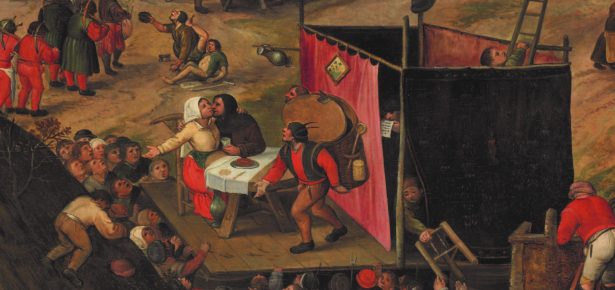
Peter Brook’s The Empty Space famously begins,
I can take any empty space and call it a bare stage. A man walks across this empty space whilst someone else is watching him, and this is all that is needed for an act of theatre to be engaged.[1]
Playing and Playgoing in Early Modern England: Actor, Audience, and Performance explores the intersections between the three realms of enquiry opened up by Brook, to focus on the player-playgoer relationship at the heart of early modern performance.
First, we explore the ‘player’: the ‘man’ (or youth, or girl) who walks (or marches, or dances, or runs, or trips, or slips suddenly away). How does an early modern player perform a virginal girl, a shamefaced blush, a ‘dead likeness’, or Othello’s trance? In tracing these questions, our contributors explore the embodied skill of the player in relation to pre-Reformation performance traditions, textual traditions of art and art history, and cultures of devotion, shame, discrimination, and identification.
Secondly, the ‘playgoer’: the ‘someone’ who is watching (and listening, clapping, shouting, stamping, nodding, identifying, and judging). The chapters in this volume illuminate the relationships between the individual playgoer (whether recovered through archival traces, or hypothesised in relation to the records of theatre programming), the imagined or implied playgoer (as registered in the paratexts of anxious or frustrated authors, and in theatrical stereotypes and onstage depictions), and the community of playgoers (both the composite ‘audience’, and the myriad ‘audiences’). Our contributors offer new insights into the experiences of documented playgoers, suggest new ways of understanding the relationship between theatre professionals and those for whom they wrote, and reconceptualise early modern drama itself in light of this relationship.
And thirdly, the ‘playhouse’: the stage itself, and the spaces – physical, social and conceptual – that surround it. In recent years, theatre historians have demonstrated that in the early modern playhouse, the stage was neither empty nor bare. Our volume asks what we can learn if we attend to the ‘fullness’ of the playhouse itself – as a conceptual and social space as well as a theatrical one – and the implications of this ‘fullness’ for the plays first performed there four centuries ago and more.
Playing and Playgoing shows how playhouses
were far from Brook’s bare stages or empty spaces: they were multisensory
places of play, pleasure, interactivity, imagination, and community. These
spaces – and the player-playgoer relationships they facilitated – shaped the
sophisticated, meta-theatrical reflections on performance that playwrights
produced for their stages. In tracing these reflections, this volume argues that the study of
theatrical culture is crucial to the scholarly investigation of dramatic texts:
not merely of historical interest, but necessary for a full understanding of
the plays themselves.
[1] Peter Brook, The Empty Space (London: Penguin Classics, 2008 [first published 1968]), 1.
Latest Comments
Have your say!